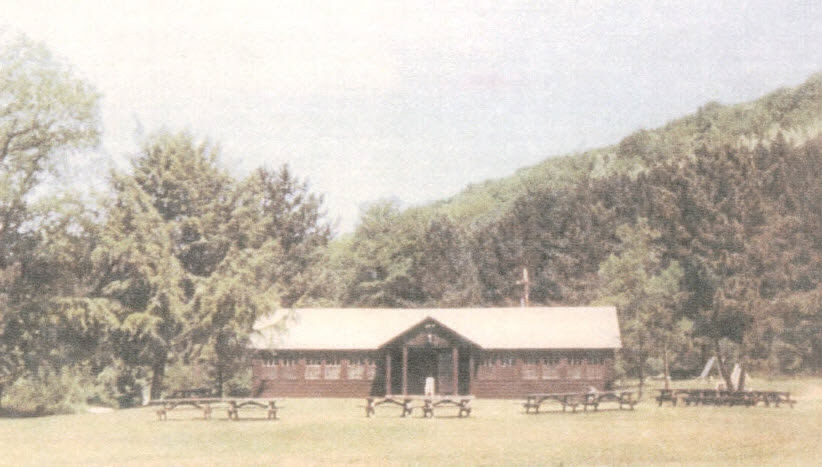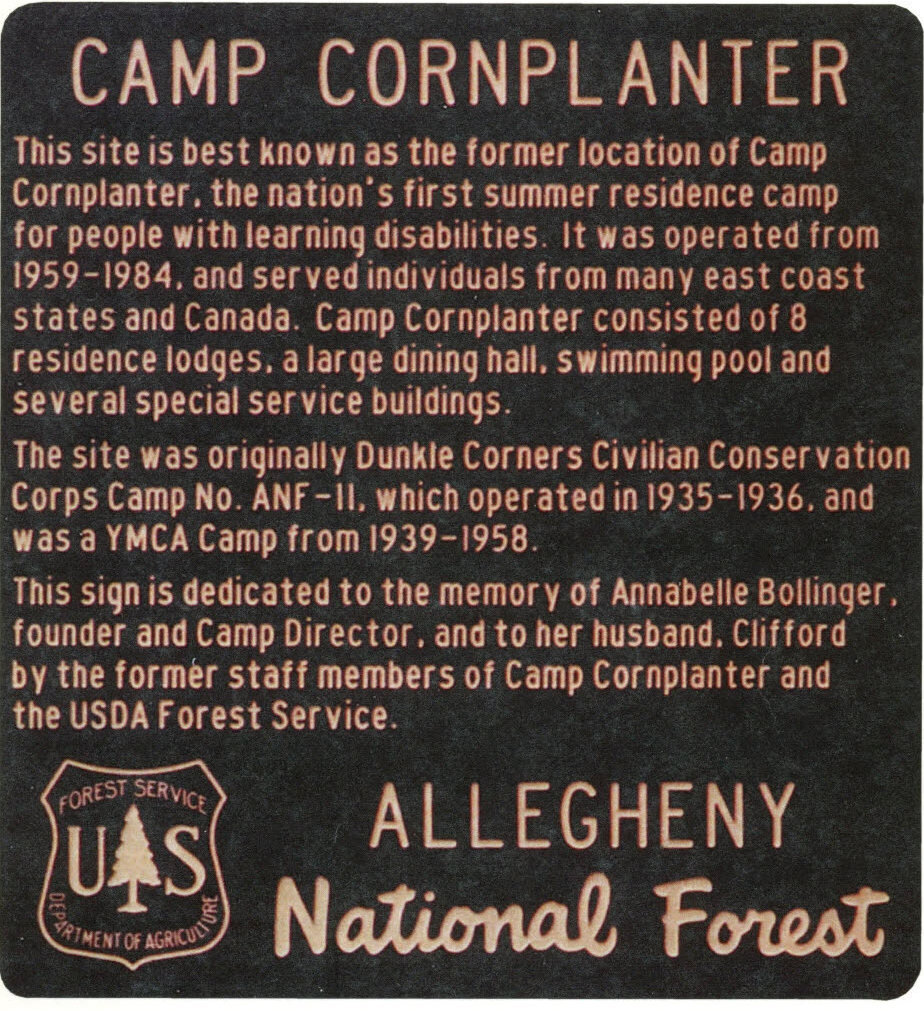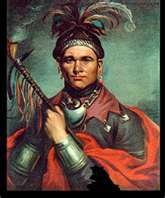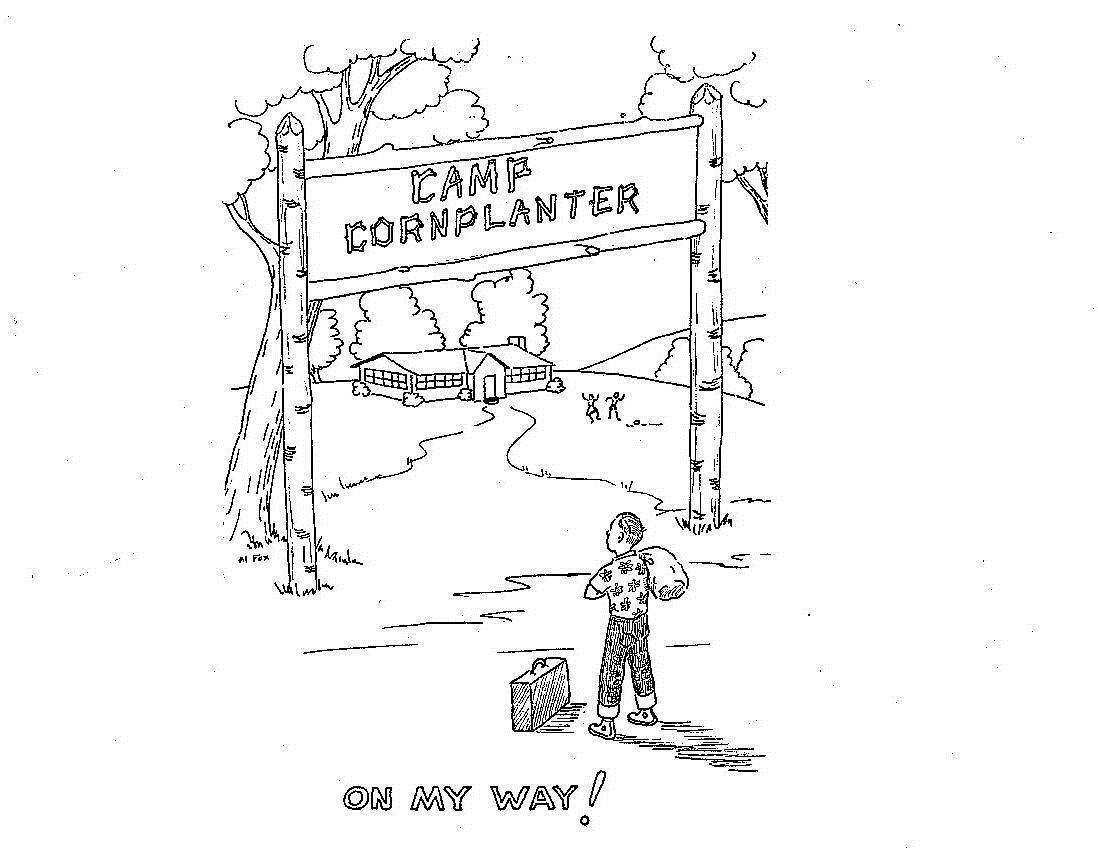
A Place in the Sun: The Story of Camp Cornplanter
Posted January 3, 2012 at 7:00 pm
By David Mack-Hardiman, Contributor
Deep within the Allegheny National Forest of Northwestern Pennsylvania, lie faint reminders of the first residential camp for persons with disabilities in North America. There are pieces of stone embedded in the landscape. Some of these are pieces of a huge stone fireplace which framed the left side of the dining hall in the photograph above. Others are pieces of concrete which lay where the playground once stood. The paths, full of aromatic pine boughs, are still crossed with old railroad ties which serve as steps. There are tenuous bridges over Dunkle Run, the small brook which snakes through the camp property. At the camp entrance, there is a rusty gate and a tire track road, rapidly being over grown with bushes and wildflowers. A short way up the road is a sign which former employees of the camp purchased to mark the location:

In 1959, Annabelle Bollinger opened this unique camp after she had searched for a camping opportunity for her son. A tireless advocate for people who had disabilities, “Mrs. B”, as she was known, decided to start what she could not find. She and her husband Cliff devoted many years to the camp, forever rounding up volunteers to help with the grounds, hiring staff for the summer sessions, and enrolling campers from many Eastern States and Canada. They named the camp, “Cornplanter," after the famous Seneca Chief. His tribal village, Jenushadago, had been located across the road. The Chief became legendary in the camp lore and each summer, someone was selected to greet the campers in the role of the Chief. On warm summer nights, the chief would appear surrounded by torch bearing braves and squaws. Upon his command, a fire would magically light in the heart of the Nature Circle. An image of the Chief, who lived to be nearly 100 years old, appears below:

In the late 1970’s, the camp’s reputation had grown far and wide and campers had to be turned away due to lack of space. The cabins surrounded a lush green valley in which there was a large swimming pool, sports field, infirmary, recreation hall and large dining hall. While the terrain was rugged, campers who used walkers were assisted when necessary. Every effort was made to include anyone regardless of their physical or intellectual disability. Some large institutions in Pennsylvania began to use the camp regularly for summer respite for their residents. The camp was sponsored by several Pennsylvania and Western New York counties including Erie County. The Variety Club of Buffalo was another loyal sponsor. The campers were grouped be gender and age and there were eight large sleeping cabins on two hills which surrounded the valley. There was a great deal of physical activity, including sporting events, swimming, and nature hikes. There were crafts, music, drama programs, and various night time events including, dances, tent-outs, star gazing, and the well-rehearsed, “Big Show of the Week." Music played a huge role at camp and singing spiritual, folk and patriotic songs was a daily occurrence. Below is a sample of the brochure from the first camp year - 1959.

The philosophy of Camp Cornplanter was described as “development of the individual." As described to the new employees, “This means that the camp knows that each camper who enters the grounds is different. He or she has his or her own special qualities that the camp wishes to develop to the fullest extent possible. There is no typical camper at Camp Cornplanter. We take all levels of ability with diverse backgrounds and try to the best of our ability to help the individual camper follow his or her own path to growth and maturity. We do not force campers to change to fit our model of what a camper would be."
Some camp days started early at 6:30 a.m. when assigned cabins were to engage in “Polar Bearing”—swimming before breakfast. Depending on the early morning temperature in the mountains, this ritual was indeed a test of endurance! Campers then hiked off to breakfast where oatmeal was a staple for the morning meal. The groups went off to various programming activities throughout the day, sometimes hiking to the Pines on the banks of the Allegheny Reservoir. One night a week, the cabins had a cook- out with another cabin group. The camp accommodations could best be described as “rustic." On each of the hills, there were cold water wash houses and latrines. Cabins were regularly visited by porcupines who enjoyed chewing on the wood underneath and bats who flew about the cabins causing more than a few shrieks! Deer were abundant and occasionally a black bear would amble through the grounds. At night, fireflies could be seen illuminating the darkness and spectacular Luna moths would rest on the cabin doors. Campers were taught to respect the natural environment and had many “once in a lifetime” experiences during the nature program each day.
Unfortunately, the cabins were high in the mountains, making it impossible for folks who use wheelchairs to stay in them. While there were times when they could stay in the recreation hall, the camp was not accessible for everyone. In addition, many more renovations were necessary to provide hot water to the cabin areas and, to modernize the ancient latrines. As the twenty-five year lease was to expire in the mid-eighties, not enough funds could be secured to bring the camp up to modern standards. Camp Cornplanter closed permanently in 1984. The camp buildings sat empty for more than fifteen years and became victims of graffiti and target practice. In 2002, the U.S. Forest Service burned all of the buildings to the ground. Former campers and employees have organized several reunions and started a college scholarship to honor the work of Mrs. Bollinger. And so, the spirit of the camp lives on!
I had the honor of working at Camp Cornplanter for six summers and was the Assistant Director of the camp in the early eighties. There are no adjectives rich enough to describe how truly beautiful it was!
- Category
- Museum of disABILITY History Blog
- Tags
- Camp Cornplanter | Disability | Personal Recollections | Recreation

Comments
Add a comment
Nancy (Dies) Campbell
Posted July 20, 2018 at 12:00 am
david L Johnson
Posted July 17, 2018 at 12:00 am
hour off at night to play spoons and devour leftovers.
\
ers
John popa
Posted March 14, 2018 at 12:00 am
Dennis O'Donnel
Posted November 14, 2017 at 12:00 am
Jeannine Rouleau
Posted November 8, 2017 at 12:00 am
David Mack- Hardiman
Posted September 6, 2017 at 12:00 am
Yes, I remember you folks. If you are on Facebook, let me know- we have a group for Cornplanter folks there. I wrote a book about the camp as well- "The Magic Fire- The Story of Camp Cornplanter"- you can get it here in the website store or, it is on Amazon.
I hope all is well- great to hear from you! Best regards,
Dave
David Mack- Hardiman
Posted September 6, 2017 at 12:00 am
Thanks for the read! We have a Facebook group for Cornplanter folks- let me know if you are interested in that. Also, I wrote a book about the camp- "The Magic Fire- The Story of Camp Cornplanter" which is available on this website in the museum store, or, on Amazon.
Great to hear from you-
Dave
Jo Ellen Kervin-Collette
Posted September 2, 2017 at 12:00 am
Scott Weaver
Posted August 7, 2016 at 12:00 am
Walter ?? was the camp director at that time. Good guy and great memories.
Debbie Schoelles
Posted June 4, 2016 at 12:00 am
Tony Chiarilli
Posted June 4, 2016 at 12:00 am
I hope you are still with us on this earth, and never forgetting
the wonderful times at Cornplanter when it was a YMCA camp. Am 81 now, and hope to be able to make an assisted trip to where the camp used to be before I die. May God bless you.
Cindy (Rolick)Graham
Posted August 27, 2015 at 12:00 am
Tony Chiarilli
Posted August 4, 2015 at 12:00 am
No, I don't remember you. But I remember Willard Avenue. Drop me an email if you still are around. I am 80 now, and Cornplanter still was the best thing in my life.
Regards,
Tony
Dave Knight
Posted June 8, 2013 at 12:00 am
You probably don't remember me. I lived next door to you & Dick on Willard Ave. I went to Camp Cornplanter way back in the 40's when I was still in the 4th Ward School before we got flooded out by the 1947/48 floods Down on Amm St. I remember sitting around a camp fire in the woods and your singing .
CJ Rodkey
Posted March 3, 2013 at 12:00 am
Tony Chiarilli
Posted February 3, 2013 at 12:00 am
Tony Chiarilli
2826 E. Church St.
Eden, NY 14057
Ralph Vanner, Jr.
Posted September 12, 2012 at 12:00 am
Great that you're keeing this alive!
RJ Vanner